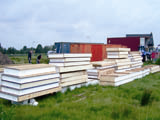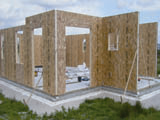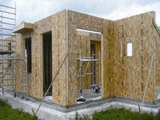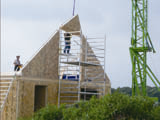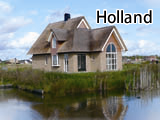
Quacent Project photos
PRODUCTS:Structural Insulated Panel
Structural insulated panels
A. Definition:
SIPs are high performance thermal efficient composite panels which consist of a sandwich of two layers of structural board with an insulating layer of foam in between for walls, roofs and floors in new residential and commercial buildings.
B. Design theory:
Structural Insulated Panels (SIPs) have become a widely used alternative construction material for homes and other buildings. While many types of Composite Panel building systems have been developed, SIPs now usually refers to panels made from a thick layer of foam (polystyrene or polyurethane) sandwiched between two layers of Oriented Strand Board (OSB), plywood or fiber-cement. The result is an engineered panel that provides structural framing, insulation, and exterior sheathing in a solid, one-piece component.
The basic design concept for SIPs is elegant in its simplicity, and offers several advantages for constructing walls and roofs. Bonding the foam core to the stiff outer skins creates a web-and-flange structural strength (along the same principal as an I-beam) across the length and breadth of the panel. With the capacity to handle axial, bending, racking, and shear loads, properly designed and assembled SIPs not only replace conventional framing, but will withstand high wind, and seismic forces.
C. Advantages to use SIPs:
1.Architectural Benefits
High quality construction method.
Comfortably warm, clean, and quiet.
2.Cost Benefits
Equal or lower first costs.
Lower long term operating costs.
Incentives available from utility service provider for energy efficient design.
Lower maintenance costs for you.
3.Construction Process Benefits
Easy to construct, with short learning curve.
60% shorter construction time
Quick turnaround time for greater satisfaction.
Increased builders production capacity.
4.Environmental Benefits
50% less framing lumber.
50% more energy efficient.
Requires less room at building site (less site disturbance).
Less construction waste.
D. Usage:
SIPs are prefabricated systems used primarily for walls and roofs. SIPs employ composite materials, reduce waste through modular construction methods, achieve high insulation values, and may be used instead of many conventional building methods.
E. Alternatives of facing/core materials:
Same characteristic of facing materials: engineered board, such as fiber cement board, MgO Board and plywood.
Sandwich insulating core: PU or XPS.
Comparison of SIPs made by different facing & core materials:
|
Facing |
Advantage |
|
OSB |
lighter, much easier to be cut, moved and decorated. OSB is made of renewable wood resources, it's green. |
|
Fiber Cement Board |
Fiber cement is stronger, both water& fire proof, and termite resistant which is suitable for tropical area where is hot, very humidity. |
|
Core |
Advantage |
Disadvantage |
|
Polyurethane |
The main advantage of polyurethane (or the much harder to pronounce derivation, polyisicyanurate) is that it has the highest R-value of any SIP panel. After what's called thermal drift, it's about 6 to 6.8 of R-value per inch of panel. |
The main detractor of urethane panels is the high cost. The other disadvantage in terms of construction is that polyurethane has a high melting point, hot wire burners (the primary method of modifying EPS and XPS panels on site) can't be used. |
|
EPS |
Over 80% of the SIP panels installed are EPS. EPS core material is widely available. It is easy to modify on sight and most sip installers have experience dealing with EPS. It's also the least expensive option in terms of material cost. |
|
|
XPS |
XPS has many of the best characteristics of both polyurethane and EPS. It has a high R-value (5 R-value per inch of panel). It is dense and stable yet has a relatively low melting point so on-site modifications are as easy as EPS. Also, like EPS, it bonds easily to OSB and gypsum board. |
Unfortunately XPS is expensive and manufactured panels are not widely available |
F. Thermal Performance of the Quacent SIP System:
The Quacent SIP s System provides wall and roof assemblies with higher overall (effective) thermal resistance (R-value) than other conventional construction methods. The overall R-value of a building assembly includes the effect of thermal bridges as a result of framing members and is a measure of its ability to resist heat flow through it. The higher the overall R-value of a building assembly, the lower the long-term energy costs will be for heating and cooling.
The table below provides typical R-Values of SIPs in different thickness:
R_Value_of_Quacent_SIPs.pdf
leakage rate for a building (quantified in terms of air changes per hour) is often used to determine the energy efficiency of building construction. Air leakage rates vary widely for different types of house construction with values of 0.2 acph or lower achievable for energy efficient house construction using the Quacent SIP System.
The combined high overall R-Value and low air leakage characteristic of buildings built with the Quacent SIP System results in significantly lower energy costs versus other construction methods such as wood frame construction.
G. Standard dimension of Quacent SIPs:
Size: 4'x8' / 4'x9' / 4'x10' / 4'x16' / 4'x20' (Feet)
220mm x 2440mm / 1220mm x 2745mm / 1220mm x 3050mm / 1220mm x 4880mm) / 1220mm x 6100mm
Thickness: 4.5" / 6.5" / 8.25" / 10.25". (Inch)
114mm / 165mm / 209mm / 260mm
Types of spline: Dimension lumber, OSB, Light Gauge Steel
H: Panel weight table:
|
|
4‘ x 8' Ft |
4' x 10' Ft |
4' x 16' Ft |
4' x 20’ Ft |
|
4.5" Inch |
45kg |
67.5kg |
90kg |
135kg |
|
6.5" Inch |
47.5kg |
71.25kg |
95kg |
142kg |
|
8.25 Inch |
50kg |
75kg |
100kg |
150kg |
|
10.25Inch |
52.5kg |
78.75kg |
105kg |
157.5kg |



